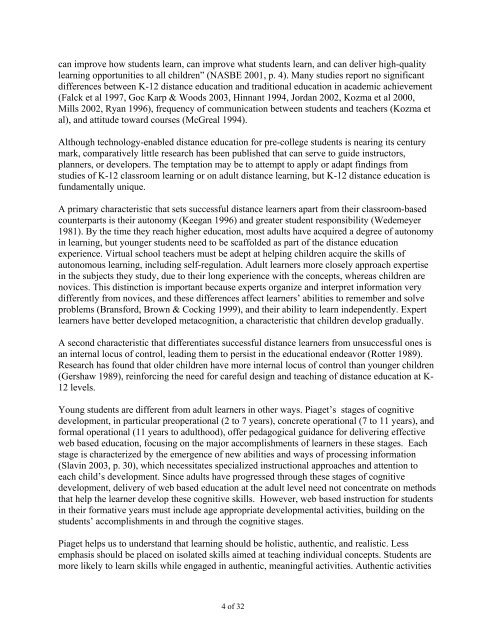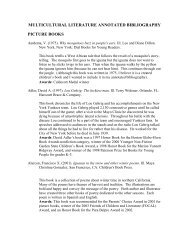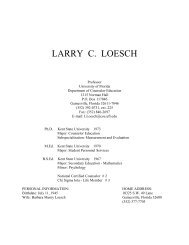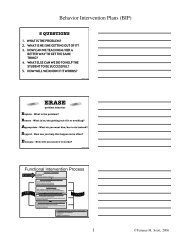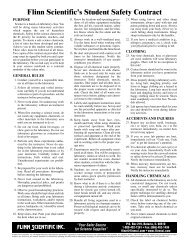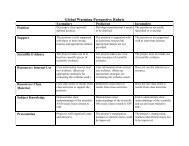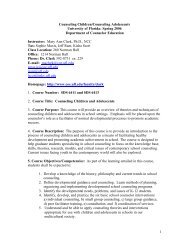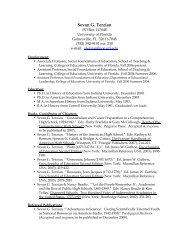The Effects of Distance Education on K-12 Student Outcomes: A ...
The Effects of Distance Education on K-12 Student Outcomes: A ...
The Effects of Distance Education on K-12 Student Outcomes: A ...
Create successful ePaper yourself
Turn your PDF publications into a flip-book with our unique Google optimized e-Paper software.
can improve how students learn, can improve what students learn, and can deliver high-quality<br />
learning opportunities to all children” (NASBE 2001, p. 4). Many studies report no significant<br />
differences between K-<strong>12</strong> distance educati<strong>on</strong> and traditi<strong>on</strong>al educati<strong>on</strong> in academic achievement<br />
(Falck et al 1997, Goc Karp & Woods 2003, Hinnant 1994, Jordan 2002, Kozma et al 2000,<br />
Mills 2002, Ryan 1996), frequency <str<strong>on</strong>g>of</str<strong>on</strong>g> communicati<strong>on</strong> between students and teachers (Kozma et<br />
al), and attitude toward courses (McGreal 1994).<br />
Although technology-enabled distance educati<strong>on</strong> for pre-college students is nearing its century<br />
mark, comparatively little research has been published that can serve to guide instructors,<br />
planners, or developers. <str<strong>on</strong>g>The</str<strong>on</strong>g> temptati<strong>on</strong> may be to attempt to apply or adapt findings from<br />
studies <str<strong>on</strong>g>of</str<strong>on</strong>g> K-<strong>12</strong> classroom learning or <strong>on</strong> adult distance learning, but K-<strong>12</strong> distance educati<strong>on</strong> is<br />
fundamentally unique.<br />
A primary characteristic that sets successful distance learners apart from their classroom-based<br />
counterparts is their aut<strong>on</strong>omy (Keegan 1996) and greater student resp<strong>on</strong>sibility (Wedemeyer<br />
1981). By the time they reach higher educati<strong>on</strong>, most adults have acquired a degree <str<strong>on</strong>g>of</str<strong>on</strong>g> aut<strong>on</strong>omy<br />
in learning, but younger students need to be scaffolded as part <str<strong>on</strong>g>of</str<strong>on</strong>g> the distance educati<strong>on</strong><br />
experience. Virtual school teachers must be adept at helping children acquire the skills <str<strong>on</strong>g>of</str<strong>on</strong>g><br />
aut<strong>on</strong>omous learning, including self-regulati<strong>on</strong>. Adult learners more closely approach expertise<br />
in the subjects they study, due to their l<strong>on</strong>g experience with the c<strong>on</strong>cepts, whereas children are<br />
novices. This distincti<strong>on</strong> is important because experts organize and interpret informati<strong>on</strong> very<br />
differently from novices, and these differences affect learners’ abilities to remember and solve<br />
problems (Bransford, Brown & Cocking 1999), and their ability to learn independently. Expert<br />
learners have better developed metacogniti<strong>on</strong>, a characteristic that children develop gradually.<br />
A sec<strong>on</strong>d characteristic that differentiates successful distance learners from unsuccessful <strong>on</strong>es is<br />
an internal locus <str<strong>on</strong>g>of</str<strong>on</strong>g> c<strong>on</strong>trol, leading them to persist in the educati<strong>on</strong>al endeavor (Rotter 1989).<br />
Research has found that older children have more internal locus <str<strong>on</strong>g>of</str<strong>on</strong>g> c<strong>on</strong>trol than younger children<br />
(Gershaw 1989), reinforcing the need for careful design and teaching <str<strong>on</strong>g>of</str<strong>on</strong>g> distance educati<strong>on</strong> at K-<br />
<strong>12</strong> levels.<br />
Young students are different from adult learners in other ways. Piaget’s stages <str<strong>on</strong>g>of</str<strong>on</strong>g> cognitive<br />
development, in particular preoperati<strong>on</strong>al (2 to 7 years), c<strong>on</strong>crete operati<strong>on</strong>al (7 to 11 years), and<br />
formal operati<strong>on</strong>al (11 years to adulthood), <str<strong>on</strong>g>of</str<strong>on</strong>g>fer pedagogical guidance for delivering effective<br />
web based educati<strong>on</strong>, focusing <strong>on</strong> the major accomplishments <str<strong>on</strong>g>of</str<strong>on</strong>g> learners in these stages. Each<br />
stage is characterized by the emergence <str<strong>on</strong>g>of</str<strong>on</strong>g> new abilities and ways <str<strong>on</strong>g>of</str<strong>on</strong>g> processing informati<strong>on</strong><br />
(Slavin 2003, p. 30), which necessitates specialized instructi<strong>on</strong>al approaches and attenti<strong>on</strong> to<br />
each child’s development. Since adults have progressed through these stages <str<strong>on</strong>g>of</str<strong>on</strong>g> cognitive<br />
development, delivery <str<strong>on</strong>g>of</str<strong>on</strong>g> web based educati<strong>on</strong> at the adult level need not c<strong>on</strong>centrate <strong>on</strong> methods<br />
that help the learner develop these cognitive skills. However, web based instructi<strong>on</strong> for students<br />
in their formative years must include age appropriate developmental activities, building <strong>on</strong> the<br />
students’ accomplishments in and through the cognitive stages.<br />
Piaget helps us to understand that learning should be holistic, authentic, and realistic. Less<br />
emphasis should be placed <strong>on</strong> isolated skills aimed at teaching individual c<strong>on</strong>cepts. <strong>Student</strong>s are<br />
more likely to learn skills while engaged in authentic, meaningful activities. Authentic activities<br />
4 <str<strong>on</strong>g>of</str<strong>on</strong>g> 32


